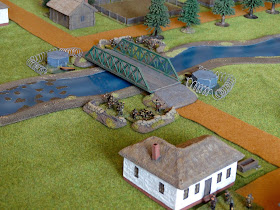I have set October 31st as the target date for completion of my Trimsos Project - that is, all the units and terrain needed for a re-fight of Donald Featherstone's 'Battle of Trimsos'. The rules I have been developing are quite playable as they are, but of course will continue to be altered as play testing continues.
I know, never set targets for a hobby project. But I reckon I'm nearly there. One of the reasons for optimism is that I have been helped over my painting wall by a bit of sub-contracting. Stuart has been waxing lyrical recently over the painting he's doing for some of his new projects, and so I caught him in a good mood and asked if he might find time to paint something for me. A good humoured but slightly sideways look resulted, but soon a price was agreed. The guy really is on a roll at the moment - in about a week I was able to collect the figures from his house - a 2 minute drive instead of paying P&P!
Now, painting standards for wargames figures can be a delicate subject. We might look at some figures and think they are a bit underpainted (or even, perish the thought, badly painted), though we would probably be polite enough to say nothing. My own painting standard I would assess as at the better end of underpainted. I have also stated my personal opinion, in a post a while back, that wargames figures can also be overpainted, an opinion which was vociferously challenged in a number of comments.
Well, let me just say that the unit of cataphracts I now have in my collection is what I would describe as just right. Colourful but not garish, detailed but not pointlessly so, impressive whether seen at wargames ranges or picked up and examined. Oh, and Stuart's suggestion to paint the kontos red was inspired. Note that no two figures are the same - here is a unit that looks elite and proud of it.
For the record these are Warlord Games Sarmatian Cataphracts, in 28mm of course.
Can't wait to get these guys into action. Do you think 'The Goldilocks Cataphracts' might be a bit too whimsical a name for these chaps? Not quite martial enough perhaps?
Anyway, enthusiasm re-kindled!
Edit: 'Goldilocks' in latin = 'Auricomus' (masculine). 'Auricomus Cataphracts' has a certain ring to it, I think.








